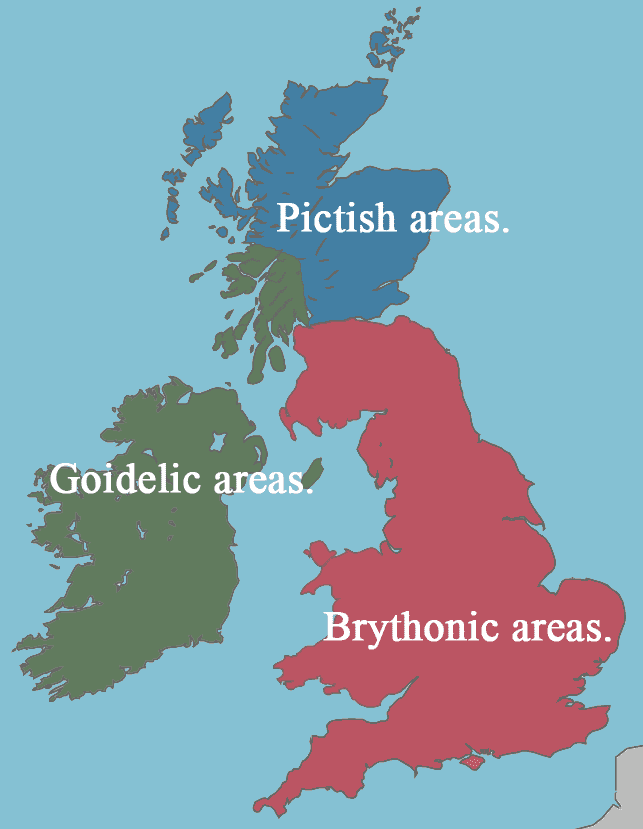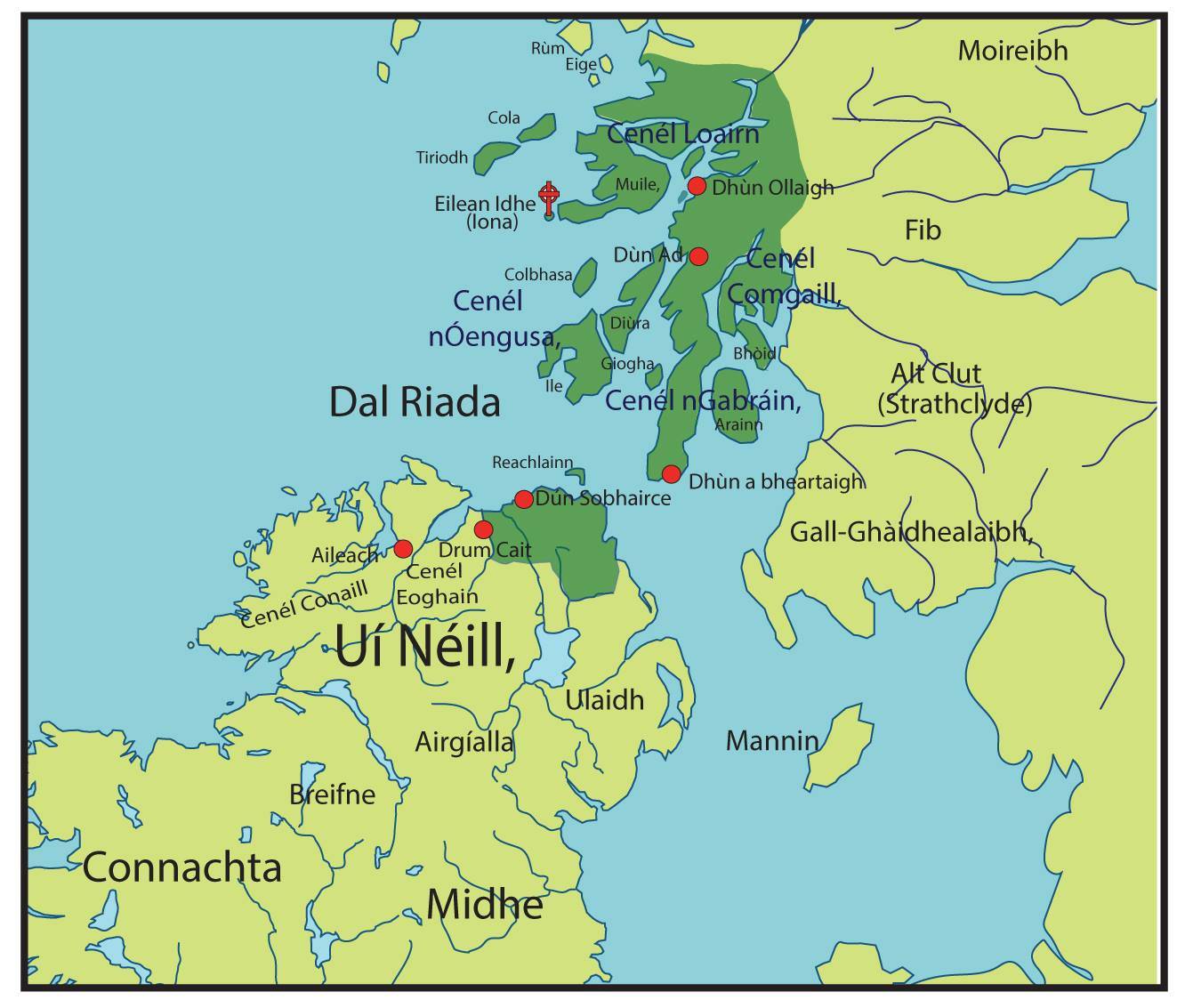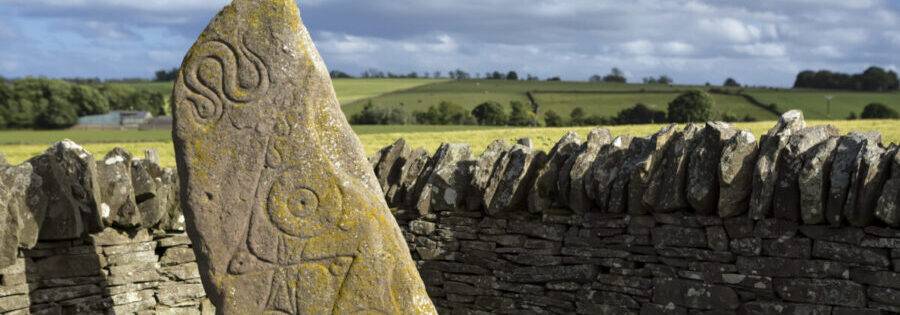
THE DÁL RIATA : TARTAN VOL.3
The term “Gaelic” first appeared in English print in the 1770s, replacing the older term “Gathelik” which dates back to at least 1596. The word “Gael,” meaning a person belonging to the Gaelic race, was first recorded in 1810. Earlier in English, the term “Goidels” was used, especially after Edward Lhuyd’s research on Celtic languages, and this usage was further popularized in academic circles by John Rhys, the first Professor of Celtic at Oxford University, particularly through his work “Celtic Britain” published in 1882.
These names originate from the Old Irish word “Goídel/Gaídel.” In Early Modern Irish, the terms were spelled “Gaoidheal” (singular) and “Gaoidheil/Gaoidhil” (plural). In contemporary Irish, these are spelled as “Gael” (singular) and “Gaeil” (plural). Scholar John T. Koch suggests that the Old Irish name was derived from an archaic Welsh term “Guoidel,” meaning “forest people,” “wild men,” or later, “warriors.” This term appears as a personal name in the Book of Llandaff. Its root is linked at the Proto-Celtic level with the Old Irish “fíad” meaning ‘wild,’ and is ultimately derived from the Proto-Indo-European *weidh-n-jo-. This Proto-Indo-European word is also the origin of “Fianna” and “Fenian.”
In medieval Ireland, the term “Gaoidheal” was specifically used by bardic poets, who were the cultural elite, to refer to individuals claiming descent from the mythical Goídel Glas. Even the Gaelicized Normans born in Ireland, who spoke Irish and patronized Gaelic bardic poetry, like Gearóid Iarla, were labeled “Gall” (foreigner) by Gofraidh Fionn Ó Dálaigh, the then Chief Ollam of Ireland.
1770年代に英語で初めて記録された「Gaelic」という言葉は、1596年に遡る古い言葉「Gathelik」に取って代わったものです。「Gael」という言葉は、「ゲール人」と定義され、1810年に初めて印刷されました。エドワード・ルイドのケルト語に関する研究により、古い英語では「Goidels」という言葉が使われるようになり、この用語はオックスフォード大学の初代ケルト学教授であるジョン・ライスによる1882年の著作『Celtic Britain』によって学術界でさらに普及しました。
これらの名前は、古アイルランド語の「Goídel/Gaídel」という言葉に由来しています。初期近代アイルランド語では、「Gaoidheal」(単数形)および「Gaoidheil/Gaoidhil」(複数形)と綴られました。現代アイルランド語では、「Gael」(単数形)および「Gaeil」(複数形)と綴られます。学者のジョン・T・コッホによると、古アイルランド語の名前は、アーカイック・ウェルシュの「Guoidel」から借用されたもので、「森の民」「野生の人々」あるいは後に「戦士」という意味です。「Guoidel」はランダフの書に個人名として記録されています。この名前の根源は、古アイルランド語の「fíad」(野生)と関連し、プロト・インド・ヨーロッパ語の*weidh-n-jo-から最終的に派生しています。このプロト・インド・ヨーロッパ語の単語は、「Fianna」と「Fenian」の起源でもあります。
中世アイルランドでは、バーディック詩人たち(国の文化知識階級)は、「Gaoidheal」という用語を、神話上のGoídel Glasから血統を主張する人々に限定して使用しました。アイルランドで生まれ、アイルランド語を話し、ゲールのバーディック詩を後援したゲール化されたノルマン人であっても、例えばGearóid Iarlaのような人物は、当時のアイルランド首席オラムであるGofraidh Fionn Ó Dálaighによって「Gall」(外国人)と呼ばれていました。

The term “Gaelic” first appeared in English print in the 1770s, replacing the older term “Gathelik” which dates back to at least 1596. The word “Gael,” meaning a person belonging to the Gaelic race, was first recorded in 1810. Earlier in English, the term “Goidels” was used, especially after Edward Lhuyd’s research on Celtic languages, and this usage was further popularized in academic circles by John Rhys, the first Professor of Celtic at Oxford University, particularly through his work “Celtic Britain” published in 1882.
These names originate from the Old Irish word “Goídel/Gaídel.” In Early Modern Irish, the terms were spelled “Gaoidheal” (singular) and “Gaoidheil/Gaoidhil” (plural). In contemporary Irish, these are spelled as “Gael” (singular) and “Gaeil” (plural). Scholar John T. Koch suggests that the Old Irish name was derived from an archaic Welsh term “Guoidel,” meaning “forest people,” “wild men,” or later, “warriors.” This term appears as a personal name in the Book of Llandaff. Its root is linked at the Proto-Celtic level with the Old Irish “fíad” meaning ‘wild,’ and is ultimately derived from the Proto-Indo-European *weidh-n-jo-. This Proto-Indo-European word is also the origin of “Fianna” and “Fenian.”
In medieval Ireland, the term “Gaoidheal” was specifically used by bardic poets, who were the cultural elite, to refer to individuals claiming descent from the mythical Goídel Glas. Even the Gaelicized Normans born in Ireland, who spoke Irish and patronized Gaelic bardic poetry, like Gearóid Iarla, were labeled “Gall” (foreigner) by Gofraidh Fionn Ó Dálaigh, the then Chief Ollam of Ireland.
1770年代に英語で初めて記録された「Gaelic」という言葉は、1596年に遡る古い言葉「Gathelik」に取って代わったものです。「Gael」という言葉は、「ゲール人」と定義され、1810年に初めて印刷されました。エドワード・ルイドのケルト語に関する研究により、古い英語では「Goidels」という言葉が使われるようになり、この用語はオックスフォード大学の初代ケルト学教授であるジョン・ライスによる1882年の著作『Celtic Britain』によって学術界でさらに普及しました。
これらの名前は、古アイルランド語の「Goídel/Gaídel」という言葉に由来しています。初期近代アイルランド語では、「Gaoidheal」(単数形)および「Gaoidheil/Gaoidhil」(複数形)と綴られました。現代アイルランド語では、「Gael」(単数形)および「Gaeil」(複数形)と綴られます。学者のジョン・T・コッホによると、古アイルランド語の名前は、アーカイック・ウェルシュの「Guoidel」から借用されたもので、「森の民」「野生の人々」あるいは後に「戦士」という意味です。「Guoidel」はランダフの書に個人名として記録されています。この名前の根源は、古アイルランド語の「fíad」(野生)と関連し、プロト・インド・ヨーロッパ語の*weidh-n-jo-から最終的に派生しています。このプロト・インド・ヨーロッパ語の単語は、「Fianna」と「Fenian」の起源でもあります。
中世アイルランドでは、バーディック詩人たち(国の文化知識階級)は、「Gaoidheal」という用語を、神話上のGoídel Glasから血統を主張する人々に限定して使用しました。アイルランドで生まれ、アイルランド語を話し、ゲールのバーディック詩を後援したゲール化されたノルマン人であっても、例えばGearóid Iarlaのような人物は、当時のアイルランド首席オラムであるGofraidh Fionn Ó Dálaighによって「Gall」(外国人)と呼ばれていました。
11世紀から英語に「アイリッシュ」という言葉が現れ、当初は「Irisce」という形で表されました。これは、アイルランドの住人を意味する古英語「Iras」に由来し、古ノルド語の「irar」の影響を受けています。その根源は、古アイルランド語の「Ériu」であり、これは古ケルト語の「*Iveriu」から来ています。この用語は、おそらく「肥沃な」を意味する原インド・ヨーロッパ語「*pi-wer-」に関連していると考えられています。Ériuは、レボル・ガバラ・エレンで言及される女神であり、トゥアハ・デ・ダナンのエルンマスの娘として描かれています。彼女は姉妹のバンバ、フォドラと共に、アイルランドを彼女の名前にちなんで名付けるためにミレジアン人と取引を行ったとされています。
古代ギリシャ人、特にプトレマイオスは彼の2世紀の著作「ジオグラフィア」で、アイルランド南西部にイヴェルニ(ギリシャ語でΙουερνοι)と呼ばれる集団を特定しました。これは以前の資料に基づいている可能性があります。学者たち、例えばT. F. O’Rahillyは、イヴェルニをアイルランド伝承のエラインと関連付けています。エラインは、エランという名のミレジアンの祖先に血統をたどる人々で、コン・オブ・ザ・ハンドレッド・バトルズやムグ・ヌアダットの子孫が台頭する前のアイルランドにおいて支配的な勢力でした。この集団には、コルク・ロイグデやダル・リアタなどの氏族が含まれていました。古代ローマの作家たち、例えばカエサル、プリニウス、タキトゥスは「イヴェルニア」という名前を基に「ハイベルニア」という名前を使用しました。
「ハイベルニアン」という名前はこれに由来しており、ローマ人はしばしばアイルランドをスコティアと呼び、その人々をスコティと呼びました。アイルランドでは、「エイレアナック」(アイリッシュ)という用語が17世紀以降、主要な識別子として現代の政治的な意味合いを持つようになりました。これは、ジェフリー・キーティングの著作で明らかであり、彼はネイティブのガオイデアルとションガール(ノルマン人)とのカトリック同盟を提案し、ヌアガイルまたはサクサナック(新しいプロテスタントのイングリッシュ入植者)に対抗することを提案しました。
スコットゲール人は、西スコットランドと北アイルランドの一部を含むダルリアダ王国から派生しました。その起源については、アイルランドからの侵攻伝説や、海によって結ばれスコットランド高地(ドゥリム・アルバン)によって他のスコットランド地域から隔てられた先住の海洋州の存在を指摘する考古学的・言語学的な証拠など、様々な説があります。彼らの遺伝的な交流の一環として、スコットランド内でM222遺伝子型の伝播が見られます。
5世紀から10世紀にかけて、現在のスコットランド地域にはダルリアダのゲール人だけでなく、ピクト人、ブリトン人、アングル人、そして後にバイキングも居住していました。ローマ人は4世紀からゲール人をラテン語で「スコティ」と呼び始め、これはゲール人が英国の西海岸を襲撃していたことから「略奪者」または「海賊」を意味すると考えられています。6世紀にダルリアダのゲール人がアーガイルに定住したにも関わらず、「スコット」という用語はゲール人全般に適用されました。例えば、ヨハネス・スコトゥス・エリウゲナやヒベルノ・ラテン文化、またゲール人によってゲルマン地域に設立されたショッテンクロスター(スコットランド修道院)にもその用例が見られます。
北ブリテンのゲール人は自らを「アルバンナイヒ」と呼び、彼らの領域を「アルバ王国」と称しました。これはダルリアダとピクトランドの後継王国として設立されました。ゲルマン系の集団はゲール人を「スコッタス」と呼び、ダンカン2世の治世下で宮廷にアングロ・サクソンの影響が強まるにつれ、「レックス・スコトルム」(スコットの王)というラテン語の称号が使われるようになり、国はスコットランドとして知られるようになりました。この文化的な変化は、デイヴィッド1世の下で完全に定着し、彼はノルマン人の台頭を促し、ローランド・ハイランドの分断を進めました。スコットランドにおけるゲルマン語話者は、彼らの言語を「イングリス」と呼んでいましたが、16世紀になると「スコティス」(スコット語)と呼ぶようになりました。一方で、スコットランド・ゲール語は「アース」と呼ばれるようになり、これは「アイルランド語」を意味します。

・Loarn (unknown death) (unknown) est.
・Fergus Mór (unknown death) (-501) est. (sometimes 496-499)
・Domangart Réti (unknown death) (501-507) est.
・Comgall (died c. 540) (507-540) est. (possibly 505-540)
・Gabrán (died c. 560) (540-560) est.
・Conall I (died c. 574) (560-574) est.
・Áedan (died c. 606) (574-606) est.
・Eochaid Buide (died c. 629) (606-629) est.
・Connad Cerr (died c. 629, before Eochaid) (-629) est.
・Domnall Brecc (died c. 642) (629-642) est.
・Ferchar (unknown death) (642-unknown) est. (before 654)
・Size and Scale: It was one of the largest battles reported in early medieval Irish history, involving considerable forces on both sides. The Annals of Ulster and other contemporary sources provide vivid descriptions of the battle.
・Political Context: The battle was part of a larger power struggle for supremacy in Ireland. Domnall’s victory helped to solidify the dominance of the Uí Néill in the north of Ireland.
・Technology and Tactics: There are indications that the battle may have involved various military tactics and the use of newer technology, which could include the use of chariots and advanced weaponry.
・Dúnchad I (died c. 654) (after 642-654) est.
・Conall Crandomna (died c. 660) (654-660) est.
・Domangart (died c. 660 ?) (660) est.
・Máel Dúin (died c. 689) (660-689) est.
・Domnall Donn (died c. 696) (689-696) est.
・Ferchar Fota (died c. 697) (696-697) est.
・Eochaid I (unknown death) (697?) est.
・Ainbcellach (deposed c. 698)
・Fiannamail (died 700) (698-700) est.
・Béc (died 707) (700-707) est.
・Dúnchad II (died 721) (707-721) est.
・Selbach (abdicated 723) (721-723) est.
・Dúngal (deposed 726) (723-726) est.
・Eochaid II (726-733)
・Muiredach (733-736)
・Alpín I (c. 736-unknown)
・Eógan (unknown-c. before 741)
・Indrechtach (died 741)
・Áed Find (before 768-778)
・Fergus (778-781) (the second)
・Eochaid III (after 781)
・Donncoirce (died 792)
・Caustantín (king of the Picts from 792-820)
・Conall II (c. 805-807)
・Conall III (c. 807-811)
・Domnall (c. 811-835)
・Óengus (c. 820-834) – king of the Picts
・Alpín II (834???) – king of the Picts and Dalriada
・Cináed (834-858) – king of the Picts (later Dalriada) – disputed
・Áed (c. 835-839)
・Eóganán (837-839) – king of the Picts
・Alpín II (834???)
・Cináéd (as king of Dalriada) (843-858) – disputed
ダール・リアタの王のリスト
これはダール・リアタ、またはダルリアダを統治した君主のリストです。ほとんどの統治期間については確実ではありませんので、いくつかの統治はその死亡年と可能な統治期間と共に示されています。726年以降の統治は、アルピン1世、エオガン、インドレハタッハの統治期間が不明である以外は、おそらく正しいでしょう。
マグ・ラスの戦い以前
・ロアーン(不明な死)(不明)推定
・ファーガス・モール(不明な死)(-501)推定(時に496-499)
・ドマンガート・レーティ(不明な死)(501-507)推定
・コムガル(紀元540年頃死去)(507-540)推定(場合によっては505-540)
・ガブラン(紀元560年頃死去)(540-560)推定
・コナル1世(紀元574年頃死去)(560-574)推定
・アエダン(紀元606年頃死去)(574-606)推定
・エオチャイド・ブイデ(紀元629年頃死去)(606-629)推定
・コナッド・ケル(エオチャイドより前に紀元629年頃死去)(-629)推定
・ドムナル・ブレック(紀元642年頃死去)(629-642)推定
・フェルチャー(不明な死)(642-不明)推定(654年前)
マグ・ラスの戦い
マグ・ラスの戦い、現代アイルランド語ではモイラの戦いとして知られているのは、637年に起こったアイルランドの歴史上重要な戦いです。この戦いは、現在の北アイルランド、ダウン県のモイラ村の近く、キルターの森で行われました。この戦いは、ゲール・アイルランド王国、ピクト人、ダール・リアタのスコット人を巻き込んだ、アイルランドとスコットランドの歴史における広範な対立の一部でした。
・規模:初期中世のアイルランド史に報告される中で最も大規模な戦闘の一つで、両側に多大な軍勢が参加しました。アルスター年代記などの同時代の資料がこの戦いの生々しい記述を提供しています。
・政治的文脈:この戦いはアイルランドの覇権をめぐる大きな力の闘争の一部でした。ドムナルの勝利は北部アイルランドでのユイ・ネールの支配を強化しました。
・技術と戦術:戦車の使用や進んだ武器など、様々な軍事戦術や新しい技術の使用が示唆されています。
マグ・ラスの戦いは、ドムナル2世と北部ユイ・ネールの軍にとって決定的な勝利で終わりました。コンガル・クレーンは戦いで死亡し、アイルランドの政治状況に重大な影響を与えました。この敗北はウラドの地位を弱め、北部でのユイ・ネールの優位を強化しました。この戦いに関する歴史的資料は、主にアイルランドの年代記で、歴史的事実と伝説的な要素が混ざっているのが一般的です。したがって、この戦いは確かに重要な歴史的事件ですが、その詳細には誇張や象徴的な要素が含まれているかもしれません。
マグ・ラスの戦いの後
・ダンチャド1世(紀元654年頃死去)(642年後-654年)推定
・コナル・クランドナ(紀元660年頃死去)(654-660)推定
・ドマンガート(紀元660年頃死去?)(660)推定
・マエル・ドゥイン(紀元689年頃死去)(660-689)推定
・ドムナル・ドン(紀元696年頃死去)(689-696)推定
・フェルチャー・フォタ(紀元697年頃死去)(696-697)推定
・エオチャイド1世(不明な死)(697?)推定
・アインベルラック(紀元698年頃廃位) ・フィアンナマイル(紀元700年死去)(698-700)推定
・ベック(紀元707年死去)(700-707)推定
・ダンチャド2世(紀元721年死去)(707-721)推定
・セルバッハ(紀元723年退位)(721-723)推定
・ドゥンガル(紀元726年廃位)(723-726)推定
・エオチャイド2世(726-733)
・ムイレダック(733-736)
・アルピン1世(約736-不明)
・エオガン(不明-紀元741年前)
・インドレハタッハ(紀元741年死去)
ピクト族 736年から750年まで、ダルリアダ地域はピクト族出身の統治者によって支配されていた可能性がありますが、この時期の特定の王については741年以降の文献に記録がありません。さらに、この時期にダルリアダがピクト族の領主の支配下で従属国または属州として機能していた可能性もあります。
740年代以降
・アエド・フィンド(768年前-778年)
・ファーガス(第2世)(778-781年)
・エオチャイド3世(781年後)
・ドンコイルチ(紀元792年死去)
・カウスタンティン(ピクト族の王、792-820年)
792年から805年の間にダール・リアタを統治した王の正体は不明ですが、ピクト族の王であるカウスタンティンがこの期間中にダール・リアタを支配していた可能性があります。
805年以降
・コナル2世(約805-807年)
・コナル3世(約807-811年)
・ドムナル(約811-835年)
不明
・オエングス(約820-834年) – ピクト族の王 ・アルピン2世(834年???) – ピクト族とダール・リアタの王
・キナード(834-858年) – ピクト族の王(後にダール・リアタ) – 議論あり
・アエド(約835-839年)
・エオガナン(837-839年) – ピクト族の王
・アルピン2世(834年???)
・キナード(ダール・リアタの王として)(843-858年) – 議論あり






